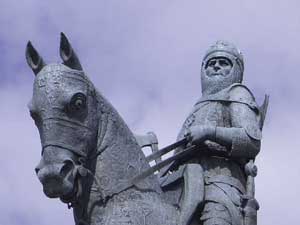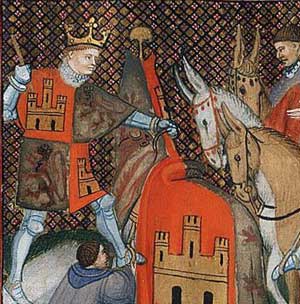
Robert the Bruce, arguably one of Scotlands best known kings died in 1329. On his deathbed he confided in his friend and lieutenant Sir James Douglas, hero of Bannockburn. Now depending on which version of this story you hear he either asked Douglas that his heart be taken from his body and presented at the Holy Sepulchre in Jerusalem or that Bruce asked Douglas to assist him in ticking off on last item from his bucket list; Bruce had never taken part in a Crusade, which for a good Christian Knight was rather bad form. Bruce’s request to take his Heart to the Holy Land therefore was very likely his attempt to take part in one last crusade (albeit in component form).
The following year Douglas set sail from Berwick with The Bruce’s heart. The heart was encased in a silver enamelled casket and set with a chain that Douglas for around his own neck.
At this time Jerusalem had been under Muslim control since 1187 and most of Spain was also under their control. The party landed first at Flanders and then set sail for Seville to join other crusading knights. On reaching Seville they joined up with the army of the King of Castille and León, Alphonso XI. (Also called Alphonso the Avenger). Alphonso was preparing to mount an attack on Arab controlled Spain and Douglas and his fellow knights travelled with them into Grenada and the castle of Teba. Its remarkable that this party included both Scots and English Knights who had only a few years earlier been knocking lumps out of each other.

As Alphonso’s army headed towards Teba a relief force under the command of Uthman bin Abi-l-Ulá was marching north with 6,000 cavalry and an unknown infantry force. They set up camp a few miles to the south of the Castle of Teba.
A medieval crusading army contained everything it needed for a long campaign including livestock, usually ‘acquired’ along the way. The restricted access to water nearby to the castle was a major vulnerability for the Christian army and the defending forces exploited this by mounting several raids on supplies and livestock, taken down to nearby watering areas.
There are several stores of how Douglas met his fate during the siege of Teba. The less colourful versions has Douglas killed while escorting one of these cattle drives which really doesn’t make an interesting story at all. Other versions have Douglas going down in the main battle itself.
On the night before the battle Uthman had taken six thousand Moorish cavalry on a flanking action and diversionary raid. However Alphonso had been warned and was ready for the attack. When the flanking force reached the Christian camp they were prepared and mounted a fierce counter attack. Uthman’s army retreated and were routed.
The more romantic accounts of the battle tell us that Douglas pursued the fleeing Moor cavalry but in his enthusiasm found himself far ahead of his own army with only a few of his companion knights. On seeing this the Moors turned and engaged them. His friend Sir William St. Clair was surrounded and Douglas rode to his aid. One story tells that Douglas in his final moment took the heart casket from around his neck and threw it into the enemy cavalry as if it was a holy relic that would defeat the Moorish army. Unfortunately no one explained the significance of this act to the Moors who took down Douglas and his companions.
After the battle the body of Douglas was recovered along with the heart casket. Douglas’ body was boiled to remove the flesh and his bones were taken back to Scotland by his surviving comrades along with Bruce’s heart. Douglas was buried at St Bride’s Kirk at Douglas in South Lanarkshire.
From this time on the Douglases would mark this event in their personal Heraldry, a red heart emblazoned on their arms.

My clansmen Sir Robert Logan and Sir Walter Logan also perished in the battle. That is how Logan got The Piercèd Heart.